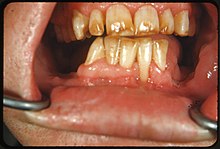User:Matthew Ferguson 57/Fluorosis
| Matthew Ferguson 57/Fluorosis |
|---|
Dental fluorosis is hypomineralization of tooth enamel caused by ingestion of excessive fluoride during enamel formation.[1] It appears as intrinsic tooth discoloration. In the mildest form, there are faint white lines. Slightly more severe cases appear as white mottled patches, while severe fluorosis is characterized by brown discoloration and brittle enamel.
Barring the most severe cases, teeth with fluorosis are relatively resistant to dental caries (tooth decay),[2] although they may be of potential cosmetic concern.[2]
Signs and symptoms[edit]

History[edit]
Galen describes what is thought to be dental fluorosis.[3] The condition first received detailed study in the United States of America. A dentist, Frederick McKay, set up practice in Colorado Springs in 1901 and discovered a high proportion of the residents had stained teeth, locally termed the "Colorado brown stain".[3] He took this information to Greene Vardiman Black, a prominent American dentist of the time. After examining specimens of affected enamel, in 1916 Black described the condition as "[a]n endemic imperfection of the enamel of the teeth, heretofore unknown in the literature of dentistry."[3] They made the interesting observation that although the mottled enamel was hypomineralized, and therefore should be more susceptible to decay, this was not the case.[3] Gradually, reports of a similar condition appeared worldwide.[3] Through epidemiological studies in the USA, Henry Trendley Dean helped to identify a causal link between high concentrations of fluoride in the drinking water and mottled enamel.[3] He also produced a classification system for dental fluorosis that is still used in modern times, Dean's Index.[3] As research continued, the protective effect of fluoride against dental decay was demonstrated.[3]
Management[edit]
Dental fluorosis may or may not be of cosmetic concern. In some cases there may be negative psychosocial effects. The treatment options, from conservative to more destructive of tooth tissue:
References[edit]
- ^ Wong, MC; Glenny, AM; Tsang, BW; Lo, EC; Worthington, HV; Marinho, VC (20 January 2010). "Topical fluoride as a cause of dental fluorosis in children". The Cochrane Database of Systematic Reviews. 2010 (1): CD007693. doi:10.1002/14651858.CD007693.pub2. PMC 8078481. PMID 20091645.
- ^ a b Neville BW; Chi AC; Damm DD (13 May 2015). Oral and Maxillofacial Pathology (4th ed.). Elsevier Health Sciences. pp. 52–54. ISBN 978-1-4557-7052-6.
{{cite book}}: Unknown parameter|coauthors=ignored (|author=suggested) (help) - ^ a b c d e f g h Fejerskov O; Kidd E (16 March 2009). Dental Caries: The Disease and Its Clinical Management. John Wiley & Sons. pp. 299–327. ISBN 978-1-4443-0928-7.
